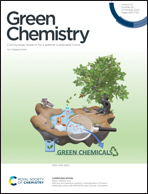“Barking” up the right tree: biorefinery from waste stream to cyclic carbonate with immobilization of CO2 for non-isocyanate polyurethanes†
Abstract
Tree bark, an under-utilized forest residue, is renewable, abundant, and inexpensive; however, biorefinery of whole bark components for advanced utilizations is rather limited due to bark's inherently refractory characteristics: high integrity, complex composition, and high heterogeneity. Herein, we report an effective strategy to directly liquefy crude bark particles into a homogeneous bark oil while chain-extending through the originally inert bark hydroxyl groups to achieve an “OH-activated” state. These activated hydroxyl groups were then epoxidized and carbonated, accompanied by a chemical fixation of CO2 at 15.7 wt% in the resulting cyclic carbonate product. The hereby synthesized carbonate was used as a precursor to prepare non-isocyanate polyurethanes (NIPUs), which showed a wide range of mechanical properties depending on the type of amine-based crosslinker selected. The ability of tuning NIPUs to achieve targeted mechanical properties makes these NIPUs applicable for various industrial applications. The novel synthetic approach developed in this study has great potential to allow us to fully utilize waste bark biomass to produce valued-added environmentally friendly products with higher sustainability.



 Please wait while we load your content...
Please wait while we load your content...